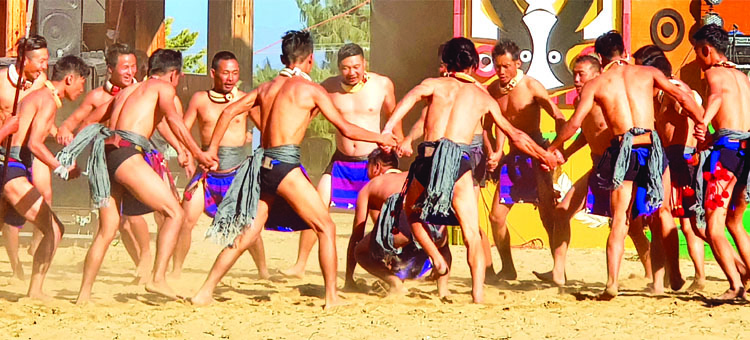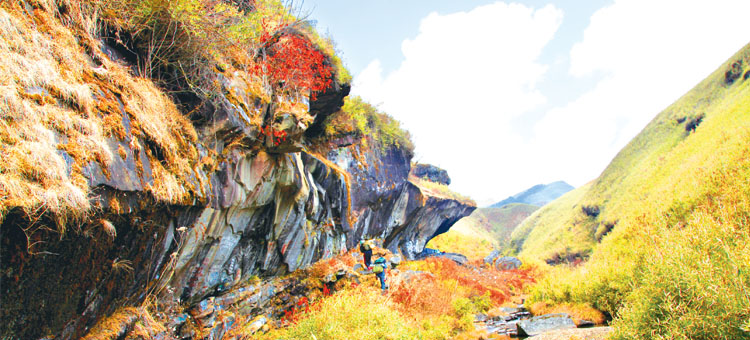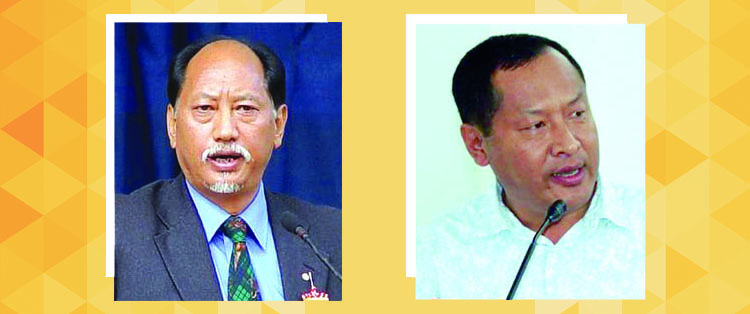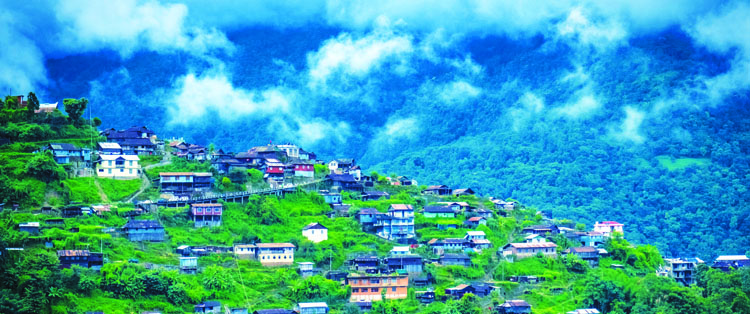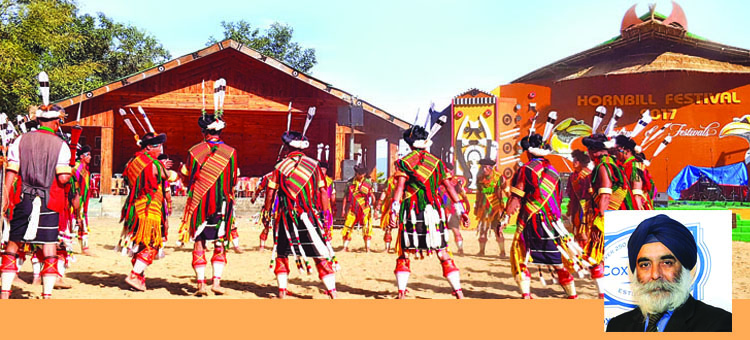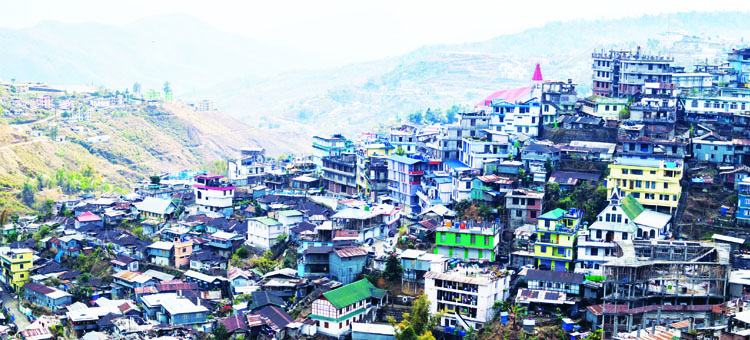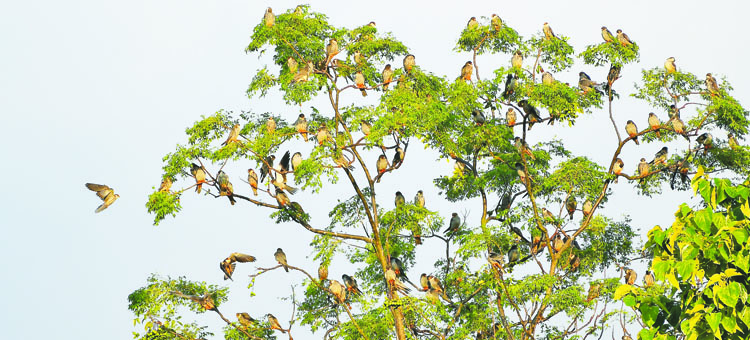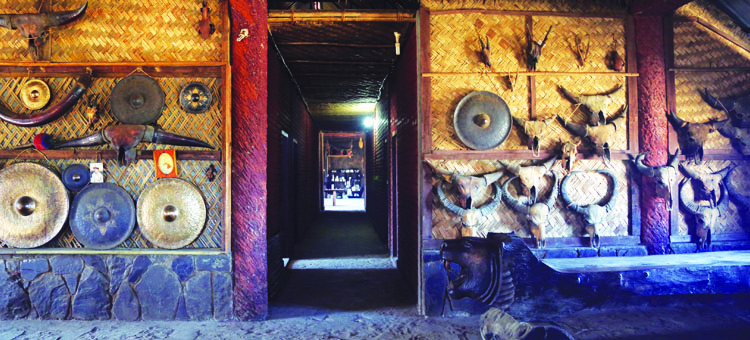Mumbai: India is finally waking up to the North East region and its immense tourism potential. The eight sister states compete with each other when it comes to natural beauty, cultural traditions, tribal lifestyles, and above all cleanliness.
The Government of India is taking major steps to improve air connectivity to the region through its UDAN scheme and has released about Rs. 200 crore under the Swadesh Darshan scheme to develop tourism infrastructure and amenities.
“We are a paradise waiting to be discovered by the world and even India. Using Central Government funds, we are focusing on infrastructure development to make the destinations tourism-friendly – wayside amenities, accommodation, pathways, waterways for connectivity etc. and basic tribal infrastructure,” says Angau I Thou IAS, Former Commissioner and Secretary, Nagaland Tourism.
Chief Minister Neiphiu Rio who assumed charge earlier this year also holds the tourism portfolio and is batting on the front foot for tourism. Recently, Nagaland accorded priority sector status to tourism under the State Industrial Policy of Nagaland 2000. The Department of Tourism, Government of Nagaland has announced that it is looking to bring out a new Tourism Policy 2018.
The Department has uploaded the Draft Tourism Policy 2018 on www.nagalandtourism.com with the aim to involve public stakeholders’ consultation in the process. A three-level organisational structure will be created to deal with this at the apex level (headed by the Chief Minister), at departmental and an attraction-specific local level.
At the institutional level, a framework which is government-led, private-sector driven and community-welfare oriented is being evolved. Sustainability will also serve as the dictum for any development and management of tourism. The State is identifying the thrust areas in the context of indigenous development and tourist’s expectation in the area of ethnic/rural tourism, agro-tourism, cultural tourism, adventure tourism and ecotourism. T Mhabemo Yanthan, NCS, who took charge as Secretary, Tourism recently is committed to sustainable tourism.
A paradise waiting to be discovered by the world and even India, the land of the Nagas, 16 distinct tribes with their own identity, is an experience so surreal, it has to be undertaken to be believed. If five star comforts and the trappings of modern day cookie cut holidays are not your cup of tea, then navigate through Nagaland, a land and people like no other
One of his earliest initiatives in the new role was a plantation drive held at Naga Heritage Village, Kisama, organised under the theme ‘Go Green’ by the Department of Tourism (DoT) in collaboration with Nagaland Bee and Honey Mission.
Nagaland is a border State facing Myanmar and the only State in India whose capital city does not have an airport. The Centre has recently announced that it will soon be sending a technical team to assess the proposed greenfield airport project at Chiethu, Kohima, before according the final approval. The commercial capital and largest city, Dimapur, has the only airport with flights to and from Kolkata and Guwahati. Dimapur is also the only city in Nagaland to be connected by train. There are direct trains to and from Delhi, Kolkata, Bengaluru and Chennai.
The Land of Festivals is a mountainous region with an interesting topography. One of the major assets of the State is its natural beauty, which manifests itself in the lush green vegetation, having a diverse flora and fauna, and deep valleys with clean rivers, amidst natural lakes, terrace cultivation and relatively pleasant climate. In addition, Nagaland has a vibrant tribal culture with 16 tribes and each one having distinct folk dances, music, festivals and handicrafts.
The local people are friendly, English speaking and happy to host visitors at their home. The Naga society is matriarchal and hence it is very normal to see the man of the house preparing a meal in the kitchen. Travelling through Nagaland feels like one is in some South East Asian country. The people closely resemble their Burmese neighbours and huge Baptist Churches dominate the landscape, more than Hindu temples. Nagaland is fast developing. So the tribal villages which were once spread all over are fast disappearing.
The State does have some wonderful sites which are always of interest to tourists. Heritage sites like the ruins of the Kachari Kingdom in Dimapur are testimony to the monolithic culture of the region. The famous Kohima War Cemetery commemorates the soldiers who sacrificed their life in one of the fiercest battles of World War II – The Battle of Kohima. Other places of interest include the scenic Dzükou Valley, Japfü Peak at Kohima, and Saramati Peak at Kiphire. The tourist village at Khonoma, Shilloi Lake at Phek, Intanki Wildlife Sanctuary at Perenand and the Zoological Park in Dimapur also have great potential for tourism.
Promising Future
Tourism experts contend that the State’s uniqueness and strategic location in North East India give Nagaland an advantage in tapping into the tourism sector for economic growth. The State has been extremely successful in promoting the Hornbill Festival, which attracts Indian and foreign tourists alike.
The key thrusts of Nagaland’s tourism are its rich culture, showcasing of history and wildlife. Tourism infrastructure is rapidly improving and experts contend this is no longer an issue as was in the past. Local initiatives and tourism pioneers are now beginning to promote a socially responsible tourism model involving participation of the councils, village elders, church and the youth.
Tourism in North East is on the rise, thanks to improved infrastructure and better air connectivity. Both domestic and foreign tourists are making their way into the North East states to explore its beauty, and have an off-the-grid vacation. It is being estimated that tourist footfall in the North East would grow by 10-12 percent in 2019. North East destinations in India include some of the most coveted places for a nature lover, with experiences that are out of the ordinary.
“The bookings for North East have gone up by 18 per cent compared to the same period (April-June) last year. Tourism in the North East region is expected to grow by at least 10-12 per cent even in the next year,” said Karan Anand, Head of Relationships, Cox & Kings. He said improved infrastructure and air connectivity have played a major role in driving tourism growth in the vast region which consists of eight States.
“The region is mostly preferred by holiday-makers, aged between 25 and 50, and hailing from metros such as Delhi, Mumbai and Kolkata, besides Guwahati and nearby areas, who flock there to explore the region’s wildlife, rivers and culture. However, the second or third-time travellers, who are now discovering the attractions of the North East, embark on their journey to understand the lifestyle, the culture and the cuisine of the region,” he added.
Echoing a similar view, a MakeMyTrip spokesperson said high growth of travellers opting for the North East sector can be attributed to not only better road infrastructure and rail connectivity, but also flight connectivity from New Delhi and Mumbai. “Apart from this, more number of hotels is opening up in this region, making it easier for travellers to find accommodations in places which were earlier not very connected.
At MakeMyTrip, we have seen over 100 per cent growth in the number of travellers opting for North East destinations such as Assam, Arunachal Pradesh and Meghalaya since the time we started offering holiday packages in the region,” he added. He said overall, the sector, including Darjeeling, is growing by 35 per cent for summer travel.
Adventure Trail
Nagaland is the land of unexplored trails and offbeat destinations. Therefore, it makes an incredible adventure hub for those seeking some adrenaline rush. The State offers good opportunity to indulge in activities like trekking, camping and motor biking, which truly make for some excellent ways of exploring this mystical land. Trekking comes as a blessing in disguise as it allows adventurists to find the hidden gems in Nagaland.
Apart from Dzükou Valley, there are thrilling treks to Saramati Peak in Kiphire District; Japfü Peak in Kohima; Mount Tiyi in Wokha; Patkai Hills, Mokokchung and Satoi Range. These trekking destinations in Nagaland are also ideal for camping. Other than these, the Governor’s Camp, in the foothills near the Doyang River, is also an ideal spot for camping. Nagaland also boasts some favourable motor biking trails, which often lead the bikers to remote villages and unsurpassed places to experience the charm of the State like never before.
While inflating lungs by trekking or biking through tough trails can earn an adventurist at heart a lot of satisfaction; there are a few recreational activities like fishing and angling which might prove to be soothing and a unique experience in Nagaland. The meandering rivers like Dhansiri, Doyang, Dikhu, Jhanji, Milak and Tula are replete with Indian Mahseer, local trout and salmon that make good targets for sport fishing.
Best Time to Visit
The climate of Nagaland is comfortable all through the year. The temperature of the State ranges from 16°C to 31°C in summer (May to July) and 4°C to 24°C during winter season. The monsoon that spreads from the month of June to early September is marked by heavy rains.
How to Reach
Air: The only airport of the State is at Dimapur, which connects Nagaland with Guwahati and Kolkata by regular flights.
Rail: The major railhead is at Dimapur, which lies on the main line of the North Eastern Frontier Railway.
Road: The Nagaland State Transport Corporation plies regular buses from Dimapur and Kohima to Guwahati, the gateway of North East India and Shillong.
Improving Air Connectivity
Under the Central Government sponsored UDAN regional airport development and connectivity scheme’s Phase-I, flights have started at Dimapur Airport. The Union Ministry of Civil Aviation is all set to send a technical team to ‘do all the necessary assessment for the final approval at the earliest’ with regard to the proposal for a Greenfield Airport at Chiethu in Kohima.
Cuisine
Predominantly non-vegetarian fare; vegetarians will struggle with limited options on the menu card. Famous dishes include snails cooked with pork and silkworm larvae, which is an expensive delicacy of the State. Galho is a vegetarian porridge cooked with rice, leaves, and condiments. Drinks include zutho and thutse, beers made with sticky rice.
MAJOR TOURIST CIRCUITS
Dimapur – Kohima – Wokha – Zunheboto – Mokukchung
Dimapur – Kohima – Khonoma – Pfutsero
Must-See Destinations
Dzukou Valley
The North Eastern valley of flowers, Dzükou is everything spellbinding. Its heap of hills and dots of flowers with two rivers that interlace with one another is truly a sight to explore. Dzükou, the bordering valley of Nagaland and Manipur is covered in green fields and grey rolling clouds that call the rain.
A trekking tour to Dzükou Valley will take one to this inviting destination traversing through Viswema village and the dense Japfü forest. The trails can get very steep and wet due to the morning dew drops but the thick forest truly comes alive and radiant in deep green shades. Dzükou Valley is undoubtedly top attraction to satiate trekkers with spectacular views of rhododendron and lily-strewn hills and hillocks
Dimapur
- Mysterious 13th Century ruins from the Kachari civilization at Rajbari Park
- Wednesday Market for spices, wicker goods, and vegetables.
- The meat section has unconventional offerings such as dog meat
- Ideal for shopping
Kisama Heritage Village
This open air museum contains a collection of traditional style tribal Nagaland buildings. There is also the Jakhama Village and Kigwema Village of the Angami tribe
Kiphire
Mt. Saramati, the highest mountain in Nagaland, is here.
The mystic land is home to four major tribes Yimchunger, Chang, Sangtam and Khiamniungan
Mon
Land of the Konyaks (most well known for being former head hunters), offers the best opportunity for finding semi-traditional villages and tattooed warriors in loincloths. Mon has the densest landscape in Nagaland, and the plains of Assam can be delightfully viewed from high up in the hills. The district’s largest village, Longwa, is situated right on the Myanmar border. In fact, the chief’s house is bisected longitudinally by the border.
Visitors to the village, who must stop by his house, will have the strange experience of sitting near the hearth with half their body in Myanmar and the other half still in India. Beginning April, visitors will be able to witness Konyaks all over Mon celebrating the Aoleong Monyu festival. Undertaken to welcome spring and pray for bountiful harvests, this happy week-long festival has plenty of feasting and sacrifices to appease the divine forces that watch over the farms
Bara Basti
The second largest village in Asia has a wide display of Naga culture and custom
Mokokchung
- Home of the Ao tribe
- Moatsu Festival during the first week of May
- Mopungchuket, positioned closer to Mokokchung town on good roads, is perhaps the best kept village in Nagaland
- Longkhum and Ungma villages
- Stay overnight in a cottage resembling a morung (traditional community house)
Kohima
War Cemetery – a tribute to the soldiers who laid down their lives pushing back the Japanese army during World War II. The bodies of around 1100 British and 330 Indian soldiers are buried here
Wokha
Home of the Lotha tribe, Wokha is a land of beautiful mountain ranges and rivers and is known for its vibrant dances and folk songs.
In the months of October, November and December tourists come to watch the Amur Falcons. Amur Falcon Conservation Week will be observed in the first week of November, coinciding with the Mini Hornbill Festival
State Museum
State Museum of Nagaland is a heritage site with lots of traditional artefacts and old possessions of the Naga people preserved
Pfutsero
- It is the highest altitude town and the coldest inhabited place in Nagaland with temperatures dropping to below zero in winters
- The Baptist Theological College in Pfutsero is one of the oldest in Nagaland
- Khezhakeno Village, where the first Nagas lived before moving on to other parts of Nagaland, is here
Tribal Tourism
The State is inhabited by 16 tribes – Angami, Ao, Chakhesang, Chang, Kachari, Khiamniungan, Konyak, Kuki, Lotha, Phom, Pochury, Rengma, Sangtam, Sumi, Yimchunger, and Zeme-Liangmai (Zeliang). Each tribe is unique in character with its own distinct customs, language and dress. Relatively new to tourism, the people are curious, warm, informal and open to attracting visitors.
One will never feel alone when visiting villages in Nagaland. Sustainable Tourism is the cornerstone of Nagaland’s tourism play and includes the Naga tribes. The government is building living spaces for them so that they can participate in the economic activity while nurturing and sustaining their ethnic culture. Travelling through Nagaland, one is certain to be engaged by the fascinating tribal village life. Colourful and unusual, it’s not something that travellers are used to seeing!
Hornbill Festival
The Hornbill Festival is a showcase of the entire Naga culture. It is an annual ten-day feature that takes place from 1-10 December. It has become a mega event not just for the 16 tribes of Nagaland, but also the remaining seven North Eastern states to showcase the best of their cultural elements. It is a mammoth task for a tourist to cover all the North Eastern states at once, hence this festival provides the ideal platform for getting a glimpse of the eight sister states of India.
SWADESH DARSHAN
Six districts have been covered under the Central Government scheme
TRIBAL CIRCUIT I
Peren–Kohima–Wokha
Sanctioned: Rs. 97.36 crore
Sanctioned: 2015
TRIBAL CIRCUIT II
Mokokchung–Tuensan–Mon
Sanctioned: Rs. 99.67 crore
Sanctioned: 2016
Travel Tips
- Allow plenty of time when travelling by car, estimate about 25 km an hour for travel time. Having own vehicle will make it much easier to stop and enjoy the drive, and also offers flexibility to visit villages along the way. In this regard, local advice is important. Roads are rocky and many still in very poor condition. Don’t underestimate the amount of time that it takes to travel in the North East region. It gets dark early, many places shut down by mid to late afternoon, and unforeseen circumstances like inclement weather are common. Road and rail infrastructure is fast improving so is air connectivity
- Be prepared for a very limited selection of food for vegetarians – Vegetable Chow Mein is really the only option available. Pick up some snacks along the way
- Places in Mizoram and Nagaland don’t have the concept of ‘lunch’. They only eat two meals a day, i.e., breakfast and dinner
- There is partial or total alcohol prohibition in three North Eastern states, i.e., Mizoram, Nagaland and Manipur. Bear in mind that visitors won’t be allowed to carry booze or find alcohol in these states very easily. And if one gets caught, the situation won’t be very pleasant
- Since this region lies on the eastern side of Bangladesh, which is 30 min ahead of Indian time, North East is at least 1 hour ahead of IST. Therefore, the sun rises and sets very early here. Don’t be surprised to find people going to bed by 8 PM and barely or no nightlife options
- The Indian government has relaxed permit requirements for foreigners to promote tourism to the North East. Foreigners no longer have to obtain permits to visit Mizoram, Manipur, and Nagaland. (The requirement still remains for Arunachal Pradesh and Sikkim). Foreigners must, however, register themselves at the Foreigner Registration Office (District Superintendent of Police) within 24 hours of entry to each state. In addition, the permit exemption doesn’t apply to citizens of specified countries, including Pakistan, Bangladesh and China, who continue to require prior approval of the Ministry of Home Affairs before their visit to these three states. Do be aware that Overseas Citizen of India card holders are classified as foreigners, and must obtain permits as required
- Accommodation: Where possible, choose homestays. Not only will visitors be helping local families generate an income, the homestays are often run professionally. None of the international or Indian hotel chains are present. Nagas are very hospitable people. Tourists especially foreign nationals can see everything first hand and even enjoy local cuisine. Do a real home stay in a small town like Dzuleke, it’s the best way to really engage with the locals on a personal level and learn more about Naga life. A nights stay per person including meals would cost less than Rs. 1500

